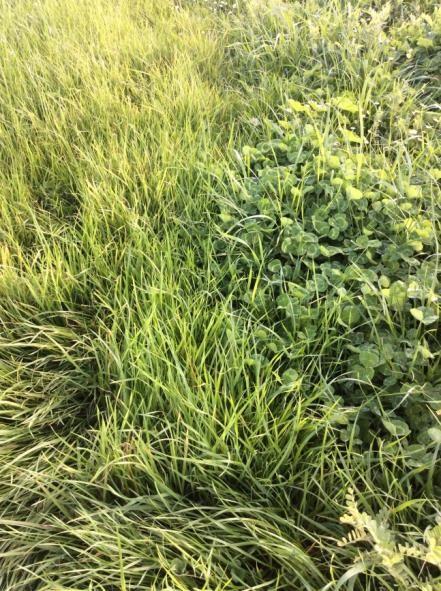 Improving legume content of kikuyu based pastures
Improving legume content of kikuyu based pastures
Paul Sanford, DPIRD, Albany WA
Author correspondence: paul.sanford@dpird.wa.gov.au
Kikuyu-based pastures frequently experience poor legume content as a consequence of kikuyu out-competing the emerging subterranean clover seedlings, many of which die due to competition for soil moisture. Other factors that lead to poor clover establishment include soil acidity, predation by red legged earth mite (RLEM) and an excess of standing kikuyu biomass that prevents light and moisture from reaching the soil surface.
There are proven methods that can be used to improve legume content in kikuyu pastures, the foremost method being grazing. Grazing kikuyu pastures heavily in the autumn pre-break of season to a residual biomass of approximately 800 to 1000 kg dry matter per ha (kgDM/ha) will open up the sward; it allows moisture and light to reach the ground and creates space in which the emerging clover seedling can develop. RLEM control is also crucial to prevent seedling losses through predation. While these approaches work well, there are situations when the producer is unable to manage kikuyu competition with these tactics leading to a kikuyu dominant pasture for much or all of the growing season. An alternative technique for reducing kikuyu competitiveness is via suppression using herbicides.
Suppressing kikuyu post-break of season
Suppressing kikuyu with glyphosate before the season break will lead to an increase in legume content within the growing season. This approach however is counterintuitive in a permanent pasture as it results in the loss of valuable out-of-season feed. The use of a grass selective herbicide following the break allows the producer to fully utilise the kikuyu out-of-season, assess whether it is likely to be a poor or good clover season and then apply the appropriate management.
Research examining the relationship between the rate of application of the grass selective chemical clethodim and percentage kikuyu ground cover (Figure 1) has demonstrated that rates between 0.5 and 1 L/ha substantially suppress kikuyu in autumn. However, the degree to which kikuyu groundcover is diminished at the same rate of clethodim varies from season to season (Figure 1). In the case of the trial data presented in Figure 1 all of the treatments had returned to around 100% kikuyu ground cover by the following year. This is not always the case however, at another site in Denbarker recovery took longer.
Kikuyu not only competes with subterranean clover but also with weeds. The extent of this competition becomes apparent when kikuyu is suppressed as plant counts of weeds such as silver grass, capeweed and chickweed quickly change from low to high. Therefore, a weed control plan needs to be considered when suppressing kikuyu; control can be implemented either before or after kikuyu suppression.

Pasture with a good legume seed bank
The majority of kikuyu based pastures have an adequate subterranean clover seed bank yet in some seasons many of these pastures frequently experience poor legume content. In a trial in Esperance, using the grass selective herbicide clethodim alone, we were able to increase legume content by 26% (Figure 2). However, while silver grass content decreased, guildford grass and a range of other weeds increased in response to the reduced competition from kikuyu.

At these recommended rates, clethodim is cheap and provides a method of increasing legume content in a pasture. This option should be considered when legume content is below that required to support adequate livestock production through winter and spring.

Pasture with a poor legume seed bank
A lesser number of kikuyu pastures have a poor legume seed bank and these require both grass suppression and sowing seed to increase legume content. The trial data presented in Figure 3 demonstrates how effective the combination of suppression and sowing of subterranean clover can be in rapidly increasing the winter clover content of a kikuyu pasture compared to only sowing or suppression alone. The trial site consisted of a kikuyu/annual ryegrass pasture with complete kikuyu cover with little or no clover content. Sowing clover in April lifted the legume content to comprise 2% of the cumulative biomass in winter. Suppression of kikuyu alone with clethodim (0.5L/ha) in April increased clover content to 15% of the biomass. However, the combination of suppression and sowing substantially lifted legume content to 55% of the biomass, or 2100 kgDM/ha, compared to the control pasture which contained no clover.
The clethodim impact on annual ryegrass resulted in a loss of 1026 kgDM/ha in total winter biomass in the suppression only treatment. Most of that loss however was recovered by sowing subterranean clover in combination with suppression (Figure 3). Interestingly, in both treatments involving suppression, broadleaf weeds become a significant component of the pasture suggesting that kikuyu had been suppressing these weeds for many years.

Key messages
- Kikuyu pastures can frequently experience poor legume content.
- Subterranean clover density can be increased in kikuyu pastures by applying sufficient grazing pressure pre-break of season if there is sufficient soil moisture, insect control and space for clover seedlings.
- Legume content can be increased post break of season using a grass selective (e.g. 0.5 to 1L/ha Clethodim) to supress kikuyu; this tactic requires an adequate legume seed bank.
- If it is necessary to sow a legume as a result of a poor seed bank, suppress kikuyu and drill in the seed (do not broadcast).
- Kikuyu suppresses legumes and weeds to a greater extent than we previously thought.
For more information visit the research library.
